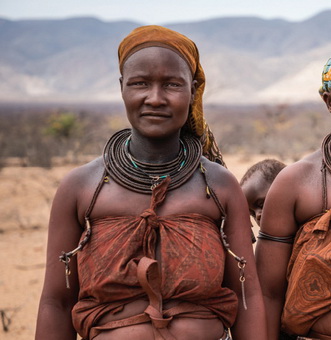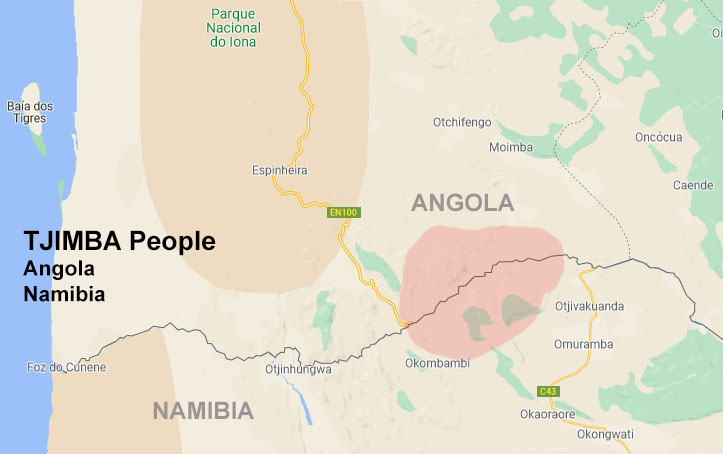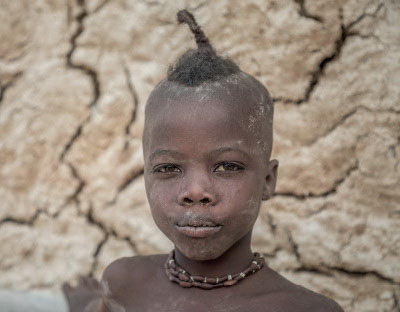

The Cimba, also spelled Tjimba, are a remote, non-Herero hunter-gatherers people of the Kaokoveld desert in northwest Namibia and southwest Angola, in the mountain ranges bordering the Kunene River. They continue to use stone tools, and use Adenium boehmianum to poison their arrows. |
 |
They speak Zemba. Ethnologue separates Zemba as a distinct language from Himba, which according to the language map of Namibia it retains under Herero proper. Maho (2009), however, sets up a Northwest Herero language, which includes Zemba; from the map, it would appear to include Himba and Hakaona as well.
(Not to be confused with Zimba language. Zimba is a Bantu language of the Democratic Republic of the Congo, spoken in a band of country south of the Elila River. It is not closely related to other languages, unless the divergent dialects Kwange and Mamba (Kyenyemamba) are considered separate languages. )
The Tjimbas are a mystery. It is unclear how many they are and exactly where they live. Neighboring tribes call them “the invisible tribe” and in the Herero language Tjimba means “he who has nothing”. Oral tradition speaks of a group of Himba who lost their livestock due to drought and were forced to modify their way of life. From being shepherds, they became gatherers and hunters, up to this day. It is not easy to locate the Tjimba in the remote mountainous region of Iona, the natural border between Angola and Namibia, where they live. Its current aesthetics is influenced by two neighboring cattle rearing tribes: the Himba and the Hakaona; but their way of life is still completely different. Their Herero neighbors portray them as Herero who have lost their cattle and are therefore impoverished, but they are a distinct people, both culturally and physically. Indeed, physically they seem to be a remnant of an indigenous population of a southern African type—along with the Kwadi, the Kwisi, and the Damara—that are unlike either the San (Bushmen) or the Bantu Herero. The mitochondrial DNA of Tjimba who have been genetically tested is similar to that of Himba, Herero, and Damara, suggesting that they descend (at least maternally) from the same Bantu ancestors.
Population and Ecosystem200 Tjimba live in the remote mountain ranges bordering the Cunene River. Economy and SocietyTraditionally, they were hunter and gatherers. Today, they practice some pastoralism. They continue to use stone tools, and Adenium boehmianum as poison for their arrows. The Tjimba are organised in small bands composed of around 20-30 members, led by an elderly man
Art and ArchitectureThe Tjimba, both women and men, are excellent craftsmen. They manufacture clothing made of leather, beautiful and iconic necklaces and comfortable leather sandals; as well as rabbit fur bracelets and wooden pipes They also finely decorate dried pumpkins with which they transport water and liquor. Their architecture is similar to that of the Himba, although somewhat simpler. In some sedentary villages in the valleys, it is possible to see stilt houses, used as huge barns. This format is used to avoid soil heat and to protect livestock (chickens and goats) from predators, such as jackals and hyenas.
Aesthetics and Belief SystemTheir neighbors, the Himba, portray them as Herero who have lost their livestock and are therefore impoverished; however, they are different people, both culturally and physically. In fact, they physically appear to be the remnants of a primitive indigenous population in southern Africa, the result of the union of San with the first Bantu groups that arrived in the region. Today, Tjimba men dress the same as Himba men, and they are usually distinguished only by being shorter. While it may be difficult to distinguish a Tjimba man from a Himba one, Tjimba women have a distinctive hairstyle and unique leather necklaces. The Tjimba children also wear original hairstyles, typical of the tribe. The Tjimba are animists and offer sacrifices (goats) to their ancestors. ChallengesLiving in a mountainous and isolated territory has its advantages. The Tjimba still keep a large part of their culture and ancient way of life thanks to the fact that they live away from large towns and highways. As a nomadic society that bases its economy on hunting and gathering, they are used to adapting to the desert ecosystem where they have lived for centuries. Possible mining projects or pressure from the guards of the Iona park could represent future threats to this invisible community. |
     |

This old picture is supposed to be from Tjimba people
Sources: